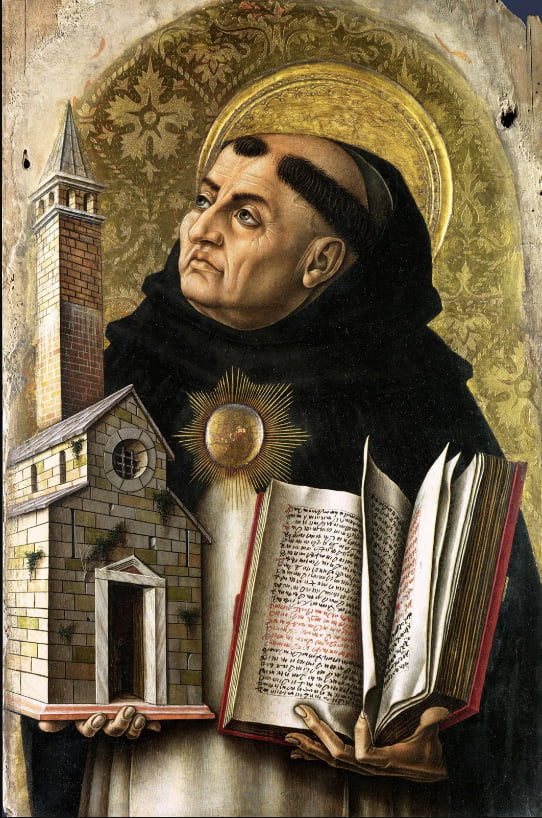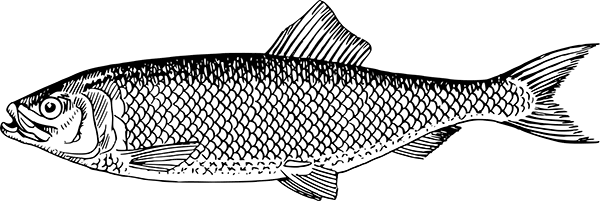Saint Thomas Aquinas and the Miracle of the Fresh Herrings, a tale to confound all doubters, in particular Franciscans and radical Aristotelians
AQUINAS, ST THOMAS

Some people don’t believe the Miracle of the Fresh Herrings to be true. Associated with Saint Thomas Aquinas during papal inquiries into his candidacy for canonisation, jokes have been made about it at least since the C15th. The world has never been short of herring doubters.
Tommaso d’Aquino was born in Sicily in 1225 AD. He became a Dominican friar and is best known for his Summa Theologica, which underpinned what became known as Thomism, a cornerstone of Western medieval thinking. In this and other works he attempted to square God and Aristotle, opening up possibilities for Christian philosophy which went on to flower in the Renaissance. He never finished the Summa, telling Brother Reginald, I cannot, because all that I have written seems to me like straw compared with what has now been revealed to me. We don’t know what the revelation was and whether it might have changed history, but most writers are familiar with the straw thing.
Having worked on the text since 1265, he reached the straw in 1273. Between 1268 and 1272 he’d been doing a third stint at the University of Paris, arguing with the radical Aristotelians or Averroistas and with the Franciscans who, while they might not have thrown Aristotle out altogether, could be described as inhabiting an Augustinian/Platonic comfort zone. It was wearing and Aquinas moved to Naples to set up a studium generale.
In Naples, also in 1273 and possibly significant in any interpretation of the Miracle of the Fresh Herrings, Domenic of Caserta came across him levitating in front of an icon of the crucifixion. Christ, who didn’t hold with radical Aristotelians and maybe wasn’t too sure about the Franciscans either, said to him, Thomas, you’ve done a top job writing all this stuff. Name your reward? Thomas came straight back, Non nisi te, Domini (Nothing but you, Lord).
The Miracle
It wasn’t until the following year that the Miracle of the Fresh Herrings was witnessed. Pope Gregory X had convened The Second Council of Lyon and wanted Thomas there, to talk on the subject of Greek errors, probably those coming from the radical Aristotelians. He hadn’t been that well, but was feeling a bit better and he set out on a donkey. He only got as far as Monte Cassino, however, where he was struck on the head by a fallen branch. Maybe he’d fallen asleep and then fell off as the donkey negotiated the obstacle in the road. Anyway, he suffered a relapse and was taken to the nearby Castle of Maenza. It was there that the miracle took place.
Thomas Aquinas has been described as corpulent, which may be unfair. In some of the paintings he seems to fill out his habit, can seem a bit jowly, but it’s more what you’d describe as comfortable. He’s reputed to have liked his food, but at Maenza he could not be persuaded to eat. Can we tempt you with anything? he was asked. I might be persuaded by some fresh herring, Thomas said.
In 1274, fresh herring was unknown in Italy. Salted or white herring, red, gold or silver herring all might have been possible, but without refrigerated and relatively quick transport fresh was not a realistic option. It was pretty much restricted to the coastal areas from which it was caught. There seem to have been rapid fish transports to Paris by the late C15th, but for Thomas Aquinas to have experienced the pleasures of fresh herring, he will almost certainly have visited one of the herring fishing ports on Normandy’s Alabaster Coast during November. This could have taken place on any of his three Parisian stints, possibly on all of them. The most likely port is Fécamp, where Robert of Normandy established a Herring Fair in 1088 and where the abbey, completed in 1220, had a scriptorium. It’s Benedictine, but the evidence suggests C13th Benedictines were open to Aristotelianism.
Anyway, it just so happened that a travelling fish merchant called Bordonario arrived at the Castle of Maenza more-or-less at the same time as Aquinas had put in his request.. Bordonario thought all he had in his baskets was salted pilchards (sardines). When they were examined, however, it was discovered, that one of them was filled with fresh herrings. Peter of Montesangiovanni, who was in the castle at the time, had seen salted herring at the papal court in Viterbo and so was able to vouch for the miracle.
He also tells us, the castle kitchens prepared the fresh herrings, boiled and fried. A bit of pan-fried herring might sound the most tempting, but boiled is often particularly recommended in historical sources. Culinary fashions change. Boiled, fried and/or miraculous, Thomas, in the end, wasn’t tempted. He didn’t eat them.
Interpretation
Some accounts say he did eat them and pronounced them delicious, but they don’t look authoritative. Some have questioned the miracle’s rejection, criticising, even mocking Thomas for it. But was Thomas being tested? And did he perhaps recognise this? He was on the record with his non nisi te, Domini. If he’d eaten them, it’s true that their virtue might have saved his life, but at the cost of his being united with God.
It’s possible to interpret the miracle as God demonstrating the extent of His love for Thomas Aquinas – and, by extension, His will with regard to radical Aristotelians and Platonists. My love for you is without bounds, Thomas, He seems to be saying, The Averroistas and the Franciscans can get their own fish; these herrings have I provided just for you. I made the herring on the Fifth Day and I was pleased. Surely, these are the finest examples of the finest fish that swims in the waters, but they are, of course, as nothing to those you will eat by My side in Heaven. The promised heavenly herrings might well have formed part of the vision which led him to not finishing his Summa Theologica.
Realising Thomas was close to death, it was deemed prudent to get him to a religious establishment as soon as possible. He was taken to the Cistercian abbey at Fossanova, where he died a month or so later, on March 7th 1274.
CANONISATION
Writing about the canonisation of Thomas Aquinas, pride of place is sometimes given to the Miracle of the Fresh Herrings, but then again sometimes it’s ignored altogether, along with the one about the tooth that was giving him trouble and fell out. The levitation doesn’t always get a mention. There need to be at least two miracles before someone can be called a saint and, technically, these have to happen after death.
He wasn’t martyred, something which tends to boost your canonisation chances. He doesn’t seem to have been one for mortifying the flesh. The Dominicans were, of course, keen and lobbied for it. The Cistercians, who held his body, were also quite keen. There were two inquiries in the early C14th and over a hundred witnesses were interviewed. A Sicilian soldier regained the use of his limbs after visiting Thomas’ tomb. A woman who’d prayed to him while hearing the bells of Fossanova Abbey was cured of a tumour in the throat.
The Franciscans were against it. Their top thinker, the subtle doctor, John Duns Scotus agreed with Aquinas on a number of points, but not enough. A Franciscan friar was quoted as saying he’d prefer to die before seeing the day when Thomas was canonised. Interestingly, God waited until the day after canonisation in July 1323 to oblige him.
A Cardinal objected to sainthood on the basis that, whilst God had sorted out the fresh herrings and had helped with the dental work, Acquinas himself had performed no coppper-bottomed miracles. The Postulator – the man appointed to make the case for canonisation – came back at him with the line, Quot articuli, tot miracula – as many articles, so many miracles; that is every one of the approximarely 3,000 articles in the Summa Theologica should be considered a miracle.
Feasts and Relics
For 646 years, the Feast Day of St Thomas Aquinas was held on March 7th, commemorating the day he died. This often conflicted with Lent, which, whilst it was great for herring eating, was less good for feasting, something the saint himself seems to have enjoyed. In 1969 the Catholic Church moved the date to January 28th, the date on which, in 1369, the fifty relic bones of his body were translated to the Church of the Jacobins (aka the Dominicans) in Toulouse.
The Dominican Order in France was disbanded following the French Revolution. Toulouse’s Church of the Jacobins was deconsecrated and handed over to the city in 1804. Aquinas’ bones were moved to the nearby Basilica of Saint-Sernin. They were returned in 1974, after its restoration as a museum.
